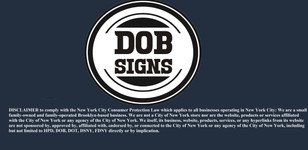In a Fire, Close All Doors Behind You (NYC Admin code 15-135)
In a Fire, Close All Doors Behind You SIGN (NYC Admin code 15-135)
Local Law 115 directed the Fire Department to require owners of multiple dwellings to post a notice in conspicuous locations indicating that those escaping a fire should close all doors behind them.
When escaping a fire, an apartment resident and the members of their household should close all doors behind themselves, including all doors within the apartment through which they exit. At all other times, public hallway corridor doors and all stairwell doors should be kept closed (except, of course, when using it to enter or exit the apartment or floor).
Some stairwell doors, and some public hallway corridor doors serving as fire and smoke barriers, are held open by a magnetic device that releases when a smoke detector on the floor activates. Such doors will close automatically, provided that there is nothing blocking them. Such doors do not have to be kept closed, but once they are released by the fire alarm system they should be allowed to close.
The rule establishes the design and content of a “Close the Door” notice and require its posting on the public hallway side of stairwell doors. The notice is to read:
In a Fire, Close All Doors Behind You!
Keep Fire and Smoke Out of Building Hallways and Stairs.
Keep Apartment and Stairwell Doors Closed at All Other Times.
Protect Your Neighbors and Your Home!
The message is visually reinforced by an image of a door ajar, with flames behind it. The final rule includes the image to be reproduced and both versions of the sign, in color; slightly modifies the size of the sign and image; and clarifies the lettering and background requirements. The final rule also clarifies that the notice must be maintained by promptly replacing any missing or damaged postings.
Read More about the Law -click Here
click here to read the final law
New York city apartment building emergency preparedness guide- click here ( mail to tenant)
NYC emergency planning and evacuations for residential building owners/managers- click here
NYC fire safety guide - click here
Where to Put close the door signs recommended by fire department:
1) Entrance to building - to inform the guest
2) On the stairwell doors on both sides
3) Inside apartment doors
" If you leave a building during a fire, close all doors as you exit. This will keep the fire inside. This includes the stairwell door. A lot of things can catch on fire such as furniture, carpeting, decorations and more. If doors are left open the flames and smoke can travel more quickly. "
DISCLAIMER to comply with the New York City Consumer Protection Law which applies to all businesses operating in New York City: We are small family-owned and family-operated Brooklyn-based business. We are not a City of New York store nor are the website, products or services affiliated with the City of New York or any agency of the City of New York. We ourselves, our business, websites, products, services, or any hyperlinks from its website are not sponsored by, approved by, affiliated with, endorsed by, or connected to the City of New York or any agency of the City of New York, including but not limited to HPD, DOB, DOT, DSNY, FDNY and federal directly or by implication.
DISCLAIMER These codes may not be the most recent version. The State / federal or other regulation department may have more current or accurate information. We make no warranties or guarantees about the accuracy, completeness, or adequacy of the information contained on this site or the information linked to on the state site. Please check official sources.
The requirements for sign content are determined by intended use and by applicable regulation. The BUYER is responsible for determining the appropriate content for a sign or package of signs. WE makes no warranty or representation of suitability of a sign for any specific application. IT IS THE CUSTOMER'S RESPONSIBILITY TO ENSURE THAT THE SIGNS THE CUSTOMER ORDERS ARE IN COMPLIANCE WITH ALL STATE, FEDERAL, LOCAL, AND MUNICIPAL LAWS. Please review terms and conditions prior to purchase.
For more information about what is required, see the laws that are referenced and the rules applicable to your city and state. This page is for informational purposes only and is not intended as legal advice, professional advice or a statement of law. You may wish to consult with an attorney.
